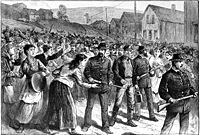
Photo from wikipedia
In this study, we investigate how labor protection institutions and the presence of controlling shareholders interact to determine a firm’s cost of equity capital in an international setting. Our firm-… Click to show full abstract
In this study, we investigate how labor protection institutions and the presence of controlling shareholders interact to determine a firm’s cost of equity capital in an international setting. Our firm- and country-level analyses reveal that firms in countries with greater labor rights have a higher cost of equity, over and above the differences explained by investor protection environments and firm- and country-level risk factors. We find that operating leverage and information asymmetry serve as channels through which labor protection increases the cost of equity capital. More interestingly, the detrimental effect of labor protection on the cost of equity is mitigated in the presence of controlling shareholders, especially in the case of a family controlling owner, indicating the effectiveness of controlling owners at coping with difficult labor relations. The economic significance of this advantage is non-trivial: a one-unit increase in the labor market regulation index increases the annual cost of equity by 0.776% in widely held firms, whereas it increases by only 0.415% in firms with controlling shareholders. Our study identifies better labor relations as a potential channel through which concentered ownership affects the interaction of labor power and the cost of equity capital.
Journal Title: Review of Quantitative Finance and Accounting
Year Published: 2019
Link to full text (if available)
Share on Social Media: Sign Up to like & get
recommendations!